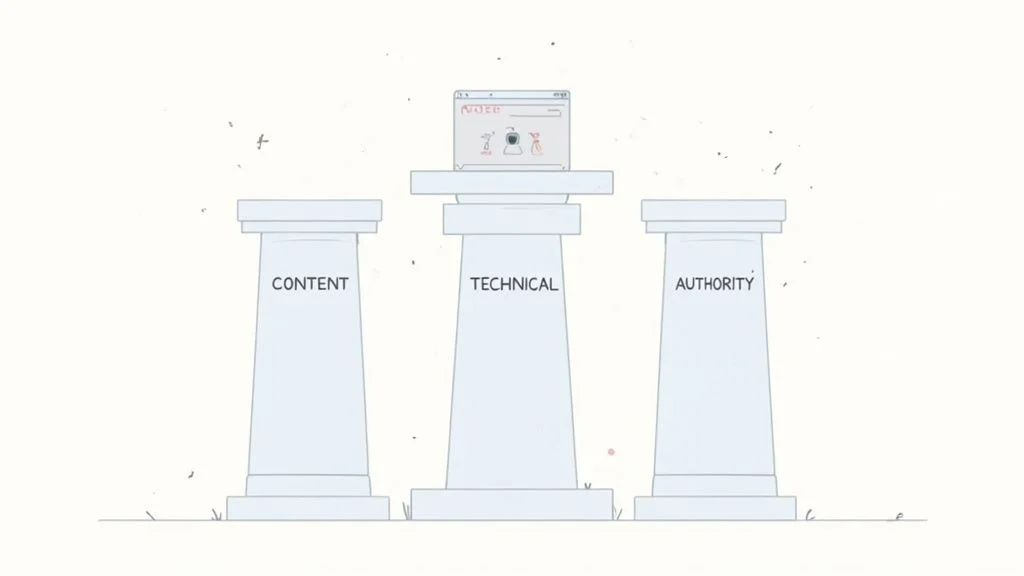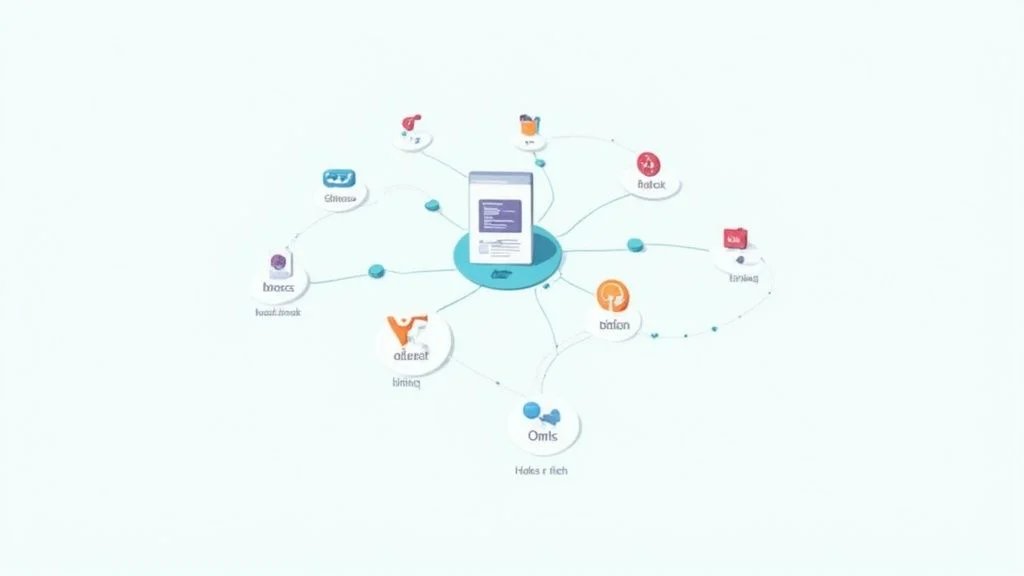
Increase Organic Search Traffic A Complete Guide
Sections
If you want to increase organic search traffic, you can’t just chase algorithm updates or look for quick hacks. It’s about building a digital presence that both search engines and actual people learn to trust. This means focusing on three things: a great user experience, genuinely helpful content, and real-world authority.
#Your Blueprint For Sustainable Traffic Growth

Before we jump into the tactics, let’s get the mindset right. Growing your organic traffic is a long game. It’s an investment, not an overnight win. It takes a methodical approach that starts with understanding what your audience actually needs and how search engines try to deliver that.
The whole game today is about delivering real value. This approach is built on three core pillars that all work together. When you get these three elements firing in sync, you create a powerful engine for bringing in qualified visitors who are actively looking for what you offer.
#The Core Pillars of Organic Traffic Growth
To build a strategy that actually lasts, you need to spread your efforts across three foundational areas. Each one sends a different but complementary signal to search engines about your site’s quality and relevance.
Think of these as the legs of a stool - if one is weak, the whole thing falls over. Here’s a quick breakdown of what they are and what they do.
| Pillar | Primary Goal | Key Activities |
|---|---|---|
| **Content Relevance** | Satisfy user intent with expert-level information. | Keyword research, topic clustering, and creating high-quality, helpful content. |
| **Technical Excellence** | Ensure your website is easily accessible to users and search engines. | Optimizing site speed, mobile-friendliness, and site architecture. |
| **Genuine Authority** | Build trust and credibility within your industry. | Earning high-quality backlinks and establishing E-E-A-T (Experience, Expertise, Authoritativeness, Trustworthiness). |
It’s crucial to see how interconnected these are. You can have the best content in the world, but it won’t rank if Google can’t crawl your site because of technical problems. On the flip side, a technically flawless site with thin, useless content isn’t going to help anyone.
The goal is to stop chasing rankings and start becoming the go-to resource in your niche. When you consistently deliver the best answers and the best experience, the traffic growth will follow.
And the data backs this up. In 2025, organic search still drives the lion’s share of website traffic, accounting for about 53% of all site visits. That number absolutely dwarfs every other channel, which shows just how powerful a solid SEO strategy continues to be.
Ultimately, this is about building a strong digital asset. If you’re looking to lay a solid foundation, digging into an ultimate small business SEO guide can provide a more detailed roadmap covering these pillars. By focusing on creating real value, you don’t just increase your traffic - you build an audience that trusts you, converts, and keeps coming back for more.
#Unlock Growth by Mastering User Intent

If there’s one secret to sustainable traffic growth, it’s moving beyond simple keyword matching. Search engines have evolved. They aren’t just word-matching machines anymore; they’re sophisticated answer engines, obsessed with satisfying the user intent behind every single search.
To win today, you have to align your content with what your audience is actually trying to do.
Think about it. Someone searching for “best running shoes” has a completely different goal than someone searching for “how to clean running shoes.” The first person is in buying mode, while the second just needs instructions. If you can create content that nails these underlying needs, you’re halfway there.
#Deconstructing the Types of User Intent
Getting a handle on the main categories of search intent lets you map your content directly to a person’s journey. By building pages that serve each purpose, you create a complete resource that catches people at every stage.
There are four big ones to focus on:
-
Informational Intent: The user just wants to know something. Their query might be a direct question like “what is content marketing” or a broader topic like “SEO best practices.”
-
Navigational Intent: The user is trying to get to a specific website. Think searches for “Rankdigger blog” or “Facebook login.”
-
Transactional Intent: The user is ready to pull the trigger and make a purchase. These searches often include words like “buy,” “price,” or “discount,” such as “buy SEO software online.”
-
Commercial Investigation: The user plans to buy soon and is comparing their options. Searches like “Rankdigger vs competitor” or “best keyword research tools” fit right in here.
The real key is matching your content format to the intent. An informational query calls for a detailed blog post. A transactional one needs a crystal-clear product page. Get this mismatch wrong, and you’ll see high bounce rates and poor rankings.
To truly see growth, your content has to resonate with what people are looking for. Creating pages that align with user intent is the bedrock of any solid traffic strategy; you can explore more with these effective content marketing strategies.
#Using Long-Tail Keywords to Uncover Intent
Broad, high-volume keywords are tempting, but they’re often brutally competitive. The real gold is frequently hiding in long-tail keywords - those longer, more specific phrases that reveal exactly what a user wants.
For example, instead of going after a massive keyword like “SEO,” you could target a long-tail version like “how to find low-competition keywords for a new blog.” Right away, that query tells you exactly what the user needs: a step-by-step process for a very specific problem.
Good content and relevance are still king, and it turns out that 69% of all search traffic now comes from these long-tail keywords. This just shows how much better search engines are getting at understanding natural, conversational language.
#Building Topic Clusters for Authority
Instead of publishing a bunch of disconnected, random blog posts, there’s a much more powerful way to organize your content: topic clusters. This model is all about creating a central, authoritative “pillar” page on a broad topic and then linking out to several in-depth “cluster” pages on related subtopics.
Let’s say you run a digital marketing agency. Your pillar page might be a massive resource called “The Ultimate Guide to Social Media Marketing.”
Then, your cluster content would drill down into the specifics:
-
“A Beginner’s Guide to Instagram Reels” This page would link back up to your main social media guide.
-
“How to Create a Winning Facebook Ad Campaign” Another detailed post that internally links to the pillar.
-
“Measuring Social Media ROI: A Practical Checklist” A third supporting article reinforcing your expertise.
This structure accomplishes two critical things. First, it creates a much better, more organized experience for visitors, keeping them on your site longer. Second, it screams to search engines that you have deep expertise on the entire topic, not just a single keyword.
This internal linking strategy spreads authority across your pages, boosting the ranking potential for the whole cluster. It’s how you go from just targeting keywords to owning a topic and becoming the go-to resource in your space. For a hands-on approach, you might want to check out our guide to performing keyword research in 30 minutes.
#Build a Rock-Solid Technical SEO Foundation

You can craft the most brilliant, helpful article in the world, but what good is it if no one can find it? This is exactly what happens when a site’s technical health gets ignored.
Think of technical SEO as the engine under the hood of your website. It’s what ensures search engines can actually crawl, index, and make sense of all your great content. Without it, any effort you put into content or links is built on a shaky foundation. This isn’t about becoming a developer overnight; it’s about getting the fundamentals right so both search bots and real people have a smooth ride.
#Prioritize Mobile-First Indexing
The way people search has changed for good. Mobile isn’t just a trend anymore - it’s the default, driving a massive 61% of all organic search engine visits. That’s a huge number you can’t afford to ignore. Check out more on the impact of these mobile search statistics if you’re curious.
Because of this shift, Google now operates on a mobile-first indexing model. This means Google primarily looks at the mobile version of your site to decide how to rank it. If your site is a mess on a smartphone - slow to load, text too small, buttons impossible to tap - your rankings will take a hit across all devices, not just mobile.
Your mobile site is your main site in Google’s eyes. It’s that simple.
#Master Your Core Web Vitals
User experience isn’t just a fuzzy concept; Google actually measures it with a set of metrics called Core Web Vitals. These metrics quantify how users experience your pages in the real world, focusing on loading speed, interactivity, and visual stability.
Put yourself in a visitor’s shoes. A page that takes forever to load is frustrating. A button that moves just as you try to click it is infuriating. These are the kinds of poor experiences that send people running - and they send bad signals to Google.
Keep an eye on these three key metrics:
-
Largest Contentful Paint (LCP): How long does it take for the main piece of content (like a big image or text block) to show up? You want this under 2.5 seconds.
-
First Input Delay (FID): How quickly does your page react when a user first clicks something? A good score here is under 100 milliseconds.
-
Cumulative Layout Shift (CLS): How much does your page’s layout jump around while it’s loading? Aim for a score below 0.1.
A fast, stable, and responsive website is no longer a “nice-to-have.” It’s a foundational element of modern SEO that directly influences whether a user stays or leaves.
The good news is you don’t have to guess. There are tools that give you detailed reports on these vitals. A powerful Lighthouse performance crawler can give you a full analysis and pinpoint exactly where you need to focus your efforts.
#Tidy Up with a Technical Audit
So many of the issues that drag a site down are completely invisible to a regular user. But to a search engine crawler, they stick out like a sore thumb. A quick technical audit helps you find and squash these bugs before they do real damage to your rankings.
Here are a few common culprits to hunt for:
-
Broken Links (404 Errors): These create dead ends for users and crawlers, wasting valuable link equity.
-
Duplicate Content: Having the same content on multiple URLs confuses search engines about which page is the “real” one to rank.
-
Clean URL Structures: Your URLs should be simple and easy to read.
yourdomain.com/blog/technical-seo-tipsis infinitely better than a messy URL likeyourdomain.com/index.php?p=123.
#Implement Structured Data for Richer Results
Finally, you can give search engines a huge helping hand with structured data, also known as schema markup. This is basically a special code you add to your pages to explicitly tell search engines what your content is all about.
For instance, you can use schema to clearly identify things like:
-
An article’s author and publishing date
-
A product’s price, availability, and review rating
-
An event’s date, time, and location
-
The steps in a how-to guide or recipe
Adding this markup can help you earn rich snippets in the search results - those eye-catching extras like star ratings, FAQs, or event details. These enhanced listings don’t just look better; they can seriously boost your click-through rates and drive more qualified traffic your way.
#Earn Authority with Strategic Link Building

Let’s be real: even with amazing content and a perfectly tuned website, search engines still look for outside validation. They need to see that other people trust you.
That’s where backlinks come in. Think of them as powerful votes of confidence from other websites. When another site links to yours, it’s a signal to Google that your content is credible enough for them to send their own audience your way.
But the game has changed. The old days of grabbing any link you could find are long gone. Today, a single backlink from a respected, relevant site is worth more than hundreds of spammy ones. Your goal isn’t just to build links; it’s to earn them.
#Move Beyond Link Building to Link Earning
So, how do you earn these powerful links? The most sustainable way is to create content that people genuinely want to link to. This simple idea is the heart of a modern “link earning” strategy. It flips the script from chasing links to creating assets so valuable that linking to you is just a natural part of the conversation.
Instead of asking for a favor, you’re creating something that makes their content better. Ask yourself what a journalist or blogger in your niche actually needs. It usually boils down to a few things:
-
Unique Data: Original research, fresh survey results, or data studies that no one else has.
-
Comprehensive Guides: A resource so thorough that it becomes the definitive answer on a topic.
-
Helpful Tools: A free calculator, template, or checklist that solves a real problem for their audience.
For example, a marketing agency could publish its own proprietary study on “The State of Small Business Social Media in 2025.” This unique data is a magnet for anyone writing about social media trends, earning natural, high-authority links without you having to beg for every single one.
The best link-building strategy is to publish something worth linking to. When your content serves as a primary source, the links will come to you, solidifying your site’s authority and helping to increase organic search traffic over the long term.
#The Power of Digital PR
Digital PR is where you actively promote these link-worthy assets. The main goal might be brand exposure, but the SEO benefit is huge: mentions in online publications almost always come with a high-quality backlink.
Let’s go back to that social media study. Once it’s published, your next move is to find journalists and bloggers who have recently written about that topic. You then reach out with a personalized email - not asking for a link, but offering them exclusive access to your new data. You’re providing real value, which makes them far more likely to feature your findings and link back to your study. It’s a true win-win.
#Don’t Forget Your Internal Linking Structure
While earning external links is critical, so many website owners forget about the power they have right at home: internal linking. These are simply links that connect one page on your website to another. They do two very important things for your SEO.
First, they help users discover more of your content, keeping them on your site longer. Second, they distribute Page Authority - a metric that predicts how well a page can rank - across your site. You can read a lot more about what Page Authority is and why it matters to really get a handle on this.
A smart internal linking strategy tells search engines which pages you consider most important. By linking from a high-authority page (like a popular blog post) to a related page you want to boost (like a service page), you can strategically pass that authority, or “link juice,” around. This can dramatically improve the ranking potential of your key commercial pages.
#Measure What Matters to Refine Your Strategy
Putting out great content and building quality links feels good, but it’s only half the battle. If you aren’t tracking your performance, you’re flying blind. It’s an old cliché, but it’s true: you can’t improve what you don’t measure. Making data-driven decisions is what separates an SEO campaign that’s just treading water from one that consistently grows.
The goal isn’t to get lost in an ocean of charts and vanity metrics. It’s about zeroing in on the numbers that tell you what’s working, what’s flopping, and where your biggest opportunities are hiding. This cycle of analysis and adjustment is the engine that will drive your long-term efforts to increase organic search traffic.
#Your SEO Command Center: Google Search Console and GA4
To get anywhere, you need two free and absolutely essential tools in your corner: Google Search Console (GSC) and Google Analytics 4 (GA4). They work in tandem to paint a full picture of your organic performance, from how people see you in search results to how they act once they land on your site.
-
Google Search Console (GSC): This is your direct line to Google. It shows you exactly how the search engine views your site. You’ll see which search queries bring you traffic, your average ranking positions, and crucially, your click-through rates.
-
Google Analytics 4 (GA4): This tool takes over once a user clicks through. It reveals what people do on your website - how long they engage with your content, whether they convert, and the paths they follow.
Think of it like this: GSC tells you what’s happening on Google’s turf, and GA4 tells you what’s happening on yours. You need both to connect the dots and make smart moves.
#Essential SEO Performance Metrics to Track
It’s incredibly easy to drown in data. Instead of trying to track everything, just focus on a handful of key metrics that give you real, actionable insights. These are the numbers that truly matter when your goal is to grow organic traffic for the long haul.
Here’s a quick rundown of the vitals to keep an eye on in Google Search Console and Google Analytics 4.
| Metric | Tool | What It Tells You |
|---|---|---|
| **Organic Clicks & Impressions** | Google Search Console | Clicks are your actual traffic. Impressions show how many times you appeared in search results. A big gap can signal a huge opportunity. |
| **Click-Through Rate (CTR)** | Google Search Console | This is the percentage of impressions that turn into a click. A low CTR often means your page titles and metas aren't doing their job. |
| **Average Position** | Google Search Console | Tracks your average ranking for keywords. This is how you see if your content optimizations are actually moving the needle. |
| **Organic Sessions** | Google Analytics 4 | This is your top-level indicator of organic search visits. At the end of the day, is this number going up? |
| **Engaged Sessions** | Google Analytics 4 | This filters out the "bouncers," showing you how many visitors actually stuck around and interacted. It's a much better gauge of traffic quality than old metrics. |
By checking in on these core metrics regularly, you can stop guessing and start knowing exactly how your efforts are paying off.
#Turning Data Into Actionable Insights
The real magic happens when you start using this data to spot opportunities. Raw numbers are just numbers; it’s the insights you pull from them that fuel growth.
Let’s walk through a classic, real-world scenario. You pop into Google Search Console and run a report to find pages with high impressions but a low click-through rate (CTR).
This is hands-down one of the most valuable reports you can pull. It’s a goldmine of quick wins, pointing you to pages Google already likes enough to show people - your headline is just failing to seal the deal.
For instance, you might spot a blog post that got 50,000 impressions last month but only has a 1% CTR. That’s a massive opportunity staring you right in the face. The page is relevant, but the title and description in the search results just aren’t grabbing anyone’s attention.
Your next steps are crystal clear:
-
Analyze the SERP: Go search for your target keyword. What kind of headlines are your competitors using? Are they using numbers, brackets, or asking questions? Get a feel for what’s already working.
-
Rewrite Your Title: Craft a more compelling, benefit-driven title tag and a persuasive meta description. Give people a reason to click on your result.
-
Monitor the Impact: Keep a close watch on that page in GSC for the next few weeks. A simple title tweak can often double or even triple its CTR, bringing in a significant traffic boost without any new content or links.
This is what data-driven SEO is all about. It’s a simple, continuous loop: measure, analyze, act, and repeat. By constantly looking for these hidden gems in your data, you can systematically level up your strategy and build unstoppable momentum.
#Got Questions About Organic Traffic?
When you’re pouring time and resources into SEO, it’s totally normal to have questions pop up. You’re probably wondering about timelines, whether other channels even matter, and what to do with that mountain of old content you’ve built up. Let’s tackle a few of the most common ones I hear all the time.
#How Long Does This Actually Take?
This is the million-dollar question, and the only honest answer is: it depends. SEO is a marathon, not a sprint. It’s about building momentum over time.
For a brand-new website with very little authority, you’re likely looking at six to twelve months of consistent work before you see significant movement. If you’re starting with a more established site that already has some credibility, you might start seeing positive shifts in as little as three to six months.
What causes that big range? A few key things:
-
Your Competition: Trying to rank for keywords in a brutal niche like finance is a much longer game than ranking for something in a smaller, local market.
-
Your Starting Point: A site with a clean technical slate and a few decent backlinks has a head start over one built from scratch.
-
Your Resources: The pace and quality of your content creation and link-building efforts are huge factors. More high-quality work, faster results.
Don’t get discouraged if things feel slow at first. Those initial months are all about laying the foundation - fixing technical glitches, publishing foundational content, and earning those first critical links. The growth you celebrate in month ten is a direct result of the groundwork you laid in month one.
#Does My Social Media Activity Even Matter for SEO?
While a “like” or a share on social media isn’t a direct ranking factor, there’s a powerful indirect connection you can’t ignore. A solid social media game can seriously amplify your content, which leads to more eyeballs, more brand recognition, and eventually, more people searching for your brand by name.
Think of it as a flywheel effect. You publish a great article and share it on LinkedIn or X. It gets in front of a whole new audience. If the content is genuinely useful, some of those people might link to it from their own blogs or websites - boom, you’ve just earned natural, high-quality backlinks.
All that exposure builds brand awareness. And when people start searching directly for your brand, that’s a signal Google absolutely loves to see.
#Should I Just Delete Old, Underperforming Content?
The idea of “content pruning” gets thrown around a lot, and while it can be effective, you have to be careful. Hitting the delete button shouldn’t be your first move. First, you need to play detective and figure out why a piece of content isn’t performing.
-
Analyze the Page: Is it getting zero traffic? Does it have zero backlinks? If an article is truly dead weight - completely outdated, irrelevant, and providing no value whatsoever - then deleting it and letting it 404 can actually be a good move. It helps consolidate your site’s authority.
-
Look for Merger Opportunities: Could this post be combined with another similar, weak article to create one comprehensive, powerhouse resource? This is a great strategy. Often, two “meh” posts can be merged into one awesome piece that performs way better.
-
Improve and Relaunch: Maybe the topic is solid, but the execution was poor. Is it badly written? Is it not optimized for the right keywords? Sometimes, a complete rewrite and a relaunch are all it takes to breathe new life into an old post.
Deleting content should be a final, strategic decision, not a weekly cleanup task. For instance, HubSpot famously removed a bunch of older posts that got high traffic but weren’t relevant to their core business (like one about the shrug emoji). It was a calculated move to sharpen their topical authority and focus on what mattered most.
Ready to stop guessing and start seeing real growth? Rankdigger provides the tools and insights you need to build a data-driven SEO strategy that works. Explore high-potential keywords and refine your approach with a platform built for results. Get started at https://rankdigger.com/en.

